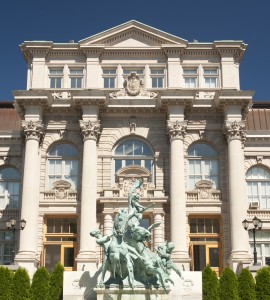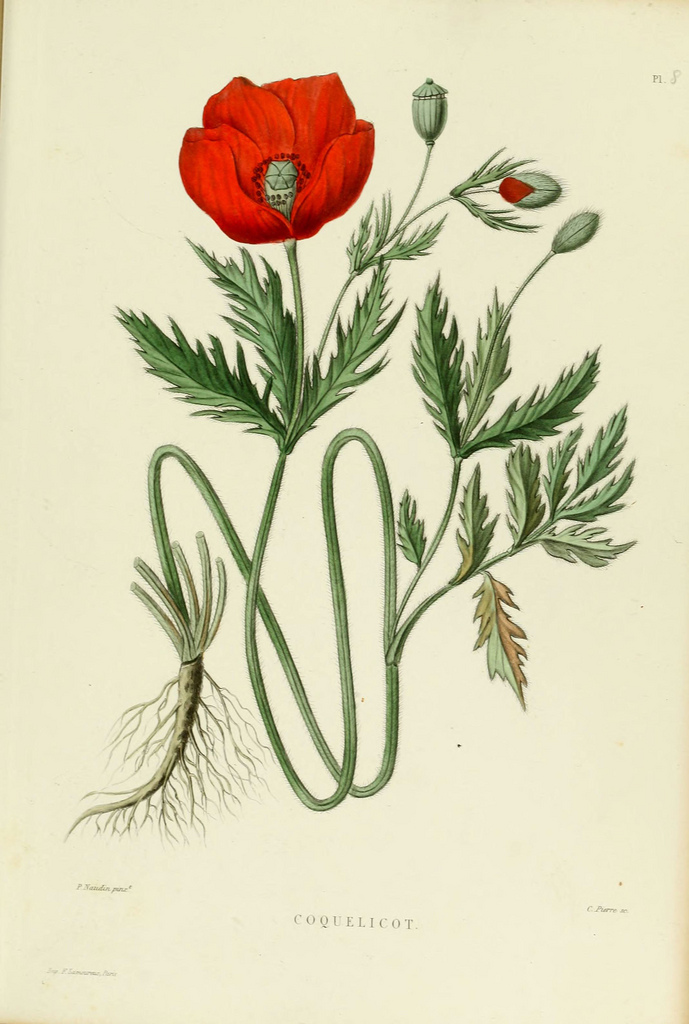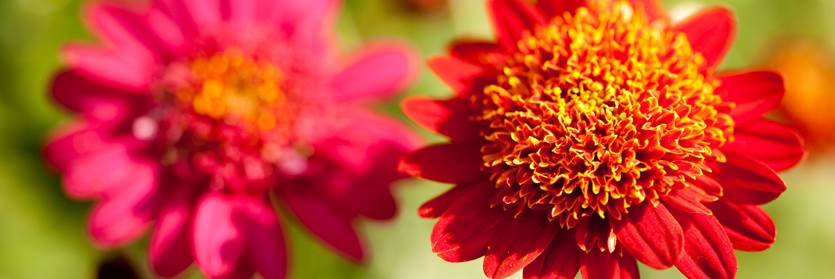Inside The New York Botanical Garden
From the Library
Posted in From the Library on April 23 2012, by Stephen Sinon
 The LuEsther T. Mertz Library is revered as a center for research in the fields of botany, horticulture, and landscape. However, it is also home to many interesting special collections which are less well-known, such as its 1,600 volume children’s collection. This collection contains books which were written for children and young adults, and its content ranges in date from the 1880s to the present. Some of these publications are great rarities, while others are illustrated by famous artists, or explain scientific, natural, or ecological principles; some pieces of the collection are story books, others are picture books, but each is made to be read and admired by children of any age.
The LuEsther T. Mertz Library is revered as a center for research in the fields of botany, horticulture, and landscape. However, it is also home to many interesting special collections which are less well-known, such as its 1,600 volume children’s collection. This collection contains books which were written for children and young adults, and its content ranges in date from the 1880s to the present. Some of these publications are great rarities, while others are illustrated by famous artists, or explain scientific, natural, or ecological principles; some pieces of the collection are story books, others are picture books, but each is made to be read and admired by children of any age.
Read More
Posted in Around the Garden, From the Library, Photography on February 2 2012, by Matt Newman
Not long ago we introduced you to a new Plant Talk series we’re calling “Past in Focus,” in which we unearth historical photographs from the LuEsther T. Mertz Library archives and attempt to recapture the scenes as they appear today. A century-old landscape undergoes any number of changes at the hands of time, weather, and ambition, leaving us drawn in by details large and small that remain untouched. You can look at these photographs and–even if only just–make out the origins of the design beneath the carefully-tended aesthetic.
In 1916, the tract surrounding the Peggy Rockefeller Rose Garden was a plane of graded soil following an idea on paper:
Read More
Posted in Around the Garden, From the Library on January 15 2012, by Matt Newman
Our historical archives are something of a treasure chest for history buffs, stuffed with 100-year-old photographs of a Garden in transition. I sometimes find myself digging through them just for contrast and comparison (and the fashion sense of our forebears; I really want to bring back flat-brimmed straw hats). My latest dig yielded some interesting results, not to mention a new series we hope to keep up with in the future.
More specifically, it produced a Library Building (better known then as the Museum Building) and its surroundings at the turn of the century:
Read More
Posted in From the Library on October 18 2011, by Mertz Library
Thomas Alva Edison died on October 18, 1931–eighty years ago today.
In the late 1920s, Edison was deeply engaged in plant research. His goal was to discover a domestic source of rubber, a plant that might produce better material than what was available at the time. (The plant turned out to be goldenrod.)
This effort was spearheaded by the Edison Botanical Corporation and funded by Henry Ford and Harvey Firestone. Research was done by the corporation and by Edison himself at The New York Botanical Garden as well as at Edison’s labs in West Orange, N.J. and Fort Myers, Florida. The great inventor spent several years periodically working at the Garden and its Library, along with assistants John Kunkel Small, Barukh Jonas, William H. Meadowcroft, and others.
Learn more about Thomas A. Edison's research at the Garden below.
Posted in From the Library on September 2 2011, by Mertz Library
The Biodiversity Heritage Library Flickr photostream contains several digital image collections, including Flowering Plants, Algae, Ferns, Fungi & Mosses, and BHL Books.
Featured in the BHL Books collection is the atlas from Jean Gourdon and Philibert Naudin’s 1871 work Nouvelle iconographie fourragère: histoire botanique, économique et agricole des plantes fourragères et des plantes nuisibles qui se rencontrent dans les prairies et les paturages : avec planches gravées sur cuivre et coloriées / par J. Gourdon, P. Naudin. This item was digitized in 2009 by The New York Botanical Garden’s Mertz Library.
The atlas includes an illustration of a coquelicot, or corn poppy:

Also available on the photostream are detailed and thumbnail views of other illustrations in the book.
(Side note: also in the 1870s, in Argenteuil, France, Claude Monet painted his famous Coquelicots (Poppies), which today resides at the Musée d’Orsay in Paris.)
The Biodiversity Heritage Library is a consortium of twelve natural history and botanical libraries that cooperate to digitize and make accessible the legacy literature of biodiversity held in their collections and to make that literature available for open access and responsible use as a part of a global “biodiversity commons.”
The LuEsther T. Mertz Library is a BHL partner.
Posted in From the Library on March 30 2011, by Plant Talk

Of course, we’re not referring to the potholes you might encounter this spring on the Mosholu Parkway or the Cross Bronx Expressway. We’re a botanical and horticultural research library after all, far more interested in natural history, so when we say potholes we mean glacial potholes.
This enormous one was photographed in 1913. Originally it would have been twelve feet deep, four to five feet in width, tapered at the bottom. And its earliest published description might have come from Nathaniel Lord Britton, first Director-in-Chief of The New York Botanical Garden, in the proceedings of the New York Academy of Sciences.
Dr. Britton told a meeting of the Academy, on June 5, 1882, that the above as well as other potholes were “brought to my notice by the late Professor A. Wood. They are located on the western bank of the Bronx River, about midway between Bronxdale and Williamsbridge…near the western end of a now dismantled and impassable bridge, with stone abutments, and in the northern part of a hemlock grove which fringes the stream for about a mile below. It is one of the most picturesque spots in the vicinity of New York City, and a walk along the little river from Bronxdale to Williamsbridge is always enjoyable.”
Housed in the archives of The LuEsther T. Mertz Library, this historical photo also accompanied “Pot-holes in The New York Botanical Garden”—an article by paleobotanist Charles Arthur Hollick, in the September 1913 issue of the Journal of the New York Botanical Garden, page 157.
“Pot-holes are bowl- or basin-like depressions in rock,” Hollick wrote, “caused by the abrasive action of gravel or cobble stones when churned around in the depressions by rapidly moving water. A pot-hole has its beginning in an irregularity or inequality in the rock bed of a stream, in which gravel or perhaps a single cobble stone or other rock fragment finds logdment. If the conditions are favorable, so that the foreign material is free to move and the current of the stream is sufficiently rapid to churn or swirl it around, the original inequality in the stream bed becomes deeper and more or less circular in shape, from the abrasive action of its contents, and a pot-hole is formed. A pot-hole, therefore, no matter where it may be located, is definite evidence that the rock in which it was excavated must have been, at some time, a part of the bed of a rapidly flowing stream.”
 The LuEsther T. Mertz Library is revered as a center for research in the fields of botany, horticulture, and landscape. However, it is also home to many interesting special collections which are less well-known, such as its 1,600 volume children’s collection. This collection contains books which were written for children and young adults, and its content ranges in date from the 1880s to the present. Some of these publications are great rarities, while others are illustrated by famous artists, or explain scientific, natural, or ecological principles; some pieces of the collection are story books, others are picture books, but each is made to be read and admired by children of any age.
The LuEsther T. Mertz Library is revered as a center for research in the fields of botany, horticulture, and landscape. However, it is also home to many interesting special collections which are less well-known, such as its 1,600 volume children’s collection. This collection contains books which were written for children and young adults, and its content ranges in date from the 1880s to the present. Some of these publications are great rarities, while others are illustrated by famous artists, or explain scientific, natural, or ecological principles; some pieces of the collection are story books, others are picture books, but each is made to be read and admired by children of any age.

